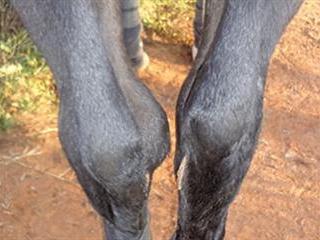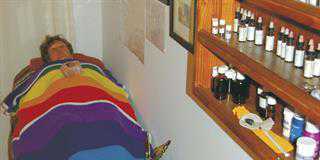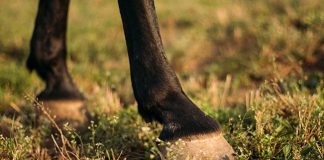
It’s thought that osteochondritis dissecans (OCD) is caused by a malfunction of endochondral ossification, which disturbs the production of cartilage and the bone supporting it. The cartilage and subchondral bone aren’t evenly laid down, and are considerably weaker than those areas that have developed normally. When the horse moves, the pressure placed on these weaker areas damages the healthy tissue.
Imagine a wall. The foundation is the bone, the first row of bricks and cement the cartilage. Now imagine that some of the bricks are different sizes and the foundation is crumbling. When the wall is put under stress (by, say, a roof) bits of brick and plaster will break away. In the same way, when the horse moves, there’s local detachment and fracture of cartilage and bone – and this is when an OCD fragment is formed.
Causes of ocd
Kept partially in place by the surrounding tissue, these fragments exist as loose flaps of tissue. If they become completely detached, they can travel throughout the joint. Whether a loose flap or ‘floating island’ the outcome is the same – terrible inflammation and pain that causes your horse to go lame. However, if you know what causes OCD then you (and your horse) stand a very good chance of avoiding this disease.
A number of factors work together to start OCD off:
- Fast growth and large body size: An unusually rapid phase of growth and/or growth to a large size can be associated with OCD.
- Nutrition: Diets very high in energy or with an imbalance in trace minerals can lead to OCD, as can poor nutrition. Horses need few concentrates when growing. Hay is best.
- Genetics: Risk of OCD may also be partially inherited.
- Hormone imbalances: This includes insulin and thyroid hormones. Feeds loaded with molasses worsen this disorder.
- Trauma: Damage to a joint is often involved in the formation and loosening of an OCD flap or fragment. Horses need to be started very gradually when it comes to exercise.
Detection
Unfortunately all of these factors can be involved in a complex series of interactions, making it impossible to predict which horses will develop OCD. OCD can be detected in foals as young as four to five months of age or as late as skeletal maturity (approximately three years). In adult horses, signs may reappear at any stage of life, especially when the OCD fragment starts to move within the joint.Depending on the location and severity of the disease, the horse may be noticeably lame or may only be lame during high-speed work.
Alternatively, it may not be lame at all and instead show a reduction in performance – something which is often only picked up by a very experienced rider. Treatment depends on the size of the island or flap. Often rest and anti-inflammatories can resolve very small lesions, but medium to large OCD fragmentation is best treated by surgery. Previously, this was risky, but now arthroscopic surgery has developed in leaps and bounds and the prognosis has improved dramatically.
Source: Practical Guide to Lameness in Horses by Ted Stashak.
Contact Kim Dyson on 082 888 6511 or at [email protected] with ‘Horse therapy’ in the subject line.













